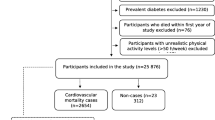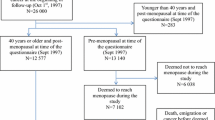Abstract
Physical activity has been associated with lower lung cancer risk in numerous studies with estimates ranging from 20 to 50% lower risk in the most versus the least active study participants. Underweight and obesity have also been associated with lower lung cancer risk, with a nonlinear, inverted U-shaped relationship. However, associations of physical activity and obesity with lung cancer are likely significantly confounded by smoking since individuals who smoke are generally less active and leaner than non-smokers, but few studies have examined these associations stratified by smoking status. Using data from 162,679 men and women who were cancer-free at enrollment (1992–1993) in the American Cancer Society Cancer Prevention Study-II Nutrition Cohort, we examined associations of baseline recreational physical activity (MET-hours per week; none, 0.1 to <8.75 (reference), 8.75–17.4, 17.5+ MET-hours/week), baseline body mass index (BMI, weight (kg)/height (m2); <18.5, 18.5–22.0 (reference), 22.1–24.9, 25.0–29.9, 30.0+ kg/m2), and waist circumference (measured in 1997; sex-specific quartiles) in relation to lung cancer risk stratified by smoking status and years since quitting among former smokers (never, current, former <10 years, former, 10–19 years, former 20+ years). Cox proportional hazards modeling computed hazard rate ratios (RR) and 95% confidence intervals (CI) while adjusting for potential confounders. During 2,384,546 person years of follow-up time, 4,669 men and women were diagnosed with lung cancer (453 among never smokers; 1,452 among current smokers; 1,194 among former smokers <10 years since quitting; 725 among former 10–19 years; and 845 among former 20+ years). Physical activity was not associated with lung cancer risk within any of the smoking strata except in former smokers less than 10 years since quitting (RR = 0.77; 95% CI 0.67–0.90 for 17.5+ MET-hours/week). Similarly, BMI was inversely associated with lung cancer in former smokers less than 10 years since quitting (RR = 0.68; 95% CI 0.55–0.84 for 30+ kg/m2) and more modestly in former smokers who quit 10–19 and 20+ years ago. Waist circumference was not associated with lung cancer risk in any smoking category. While being physically active and maintaining a healthy body weight are important for prevention of various chronic diseases, including several types of cancer, our results suggest that physical activity, BMI, and waist circumference are not associated with lung cancer risk, regardless of smoking status.
Similar content being viewed by others
References
American Cancer Society (2016) Cancer facts & figures 2016. American Cancer Society, Atlanta
National Center for Chronic Disease Prevention and Health Promotion (US) Office on Smoking and Health (2014) The health consequences of smoking—50 years of progress: a report of the surgeon general. Centers for Disease Control and Prevention (US), Atlanta
Brenner D et al (2016) Leisure-time physical activity and lung cancer risk: a systematic review and meta-analysis. Lung Cancer 95:17–27
Duan P et al (2015) Body mass index and risk of lung cancer: systematic review and dose-response meta-analysis. Sci Rep 5:16938
Lauby-Secretan L et al (2016) Body fatness and cancer—viewpoint of the IARC working group. N Engl J Med 375:794–798
Dewi NU et al (2016) Anthropometry and the risk of lung cancer in EPIC. Am J Epidemiol 184(2):129–139
Kabat GC et al (2008) Body mass index and waist circumference in relation to lung cancer risk in the women’s health initiative. Am J Epidemiol 168(2):158–169
Lam T et al (2013) Anthropometric measures and physical activity and the risk of lung cancer in never-smokers: a prospective cohort study. PLoS ONE 8(8):e70672
Olson JE et al (2002) Differential association of body mass index and fat distribution with three major histologic types of lung cancer: evidence from a cohort of older women. Am J Epidemiol 156(7):606–615
Calle EE et al (2002) The American Cancer Society Cancer Prevention Study II nutrition cohort-rational, study design, and baseline characteristics. Cancer 94:500–511
Bergmann MM et al (1998) Validity of self-reported cancers in a prospective cohort study in comparison with data from state cancer registries. Am J Epidemiol 147(6):556–562
Calle EE, Terrell D (1993) Utility of the National Death Index for ascertainment of mortality among Cancer Prevention Study II participants. Am J Epidemiol 137:235–241
World Health Organization (1977) International classification of diseases ninth revision. Manual of the international statistical classification of disease, injuries, and causes of death. WHO, Geneva
World Health Organization (1992) International statistical classification of diseases and related health problems tenth revision. WHO, Geneva
Ainsworth BE et al (2000) Compendium of physical activities: an update of activity codes and MET intensities. Med Sci Sports Exerc 32(9 Suppl):S498–S504
World Health Organization (1995) Physical status: the use and interpretation of anthropometry: report of a WHO Expert Committee, pp 1–452
Moore S et al (2016) Association of leisure-time physical activity with risk of 26 types of cancer in 1.44 million adults. JAMA Intern Med 176:816–825
Henley S et al (2002) Leanness and lung cancer risk: fact or artifact? Epidemiology 13:268–276
Leitzmann MF et al (2009) Prospective study of physical activity and lung cancer by histologic type in current, former, and never smokers. Am J Epidemiol 169(5):542–553
World Cancer Research Fund/American Institute for Cancer Research (2007) Food, nutrition, physical activity and the prevention of cancer: a global perspective. AICR, Washington, DC
Chiolero A et al (2008) Consequences of smoking for body weight, body fat distribution, and insulin resistance. Am J Clin Nutr 87(4):801–809
Clair C et al (2011) Dose-dependent positive association between cigarette smoking, abdominal obesity and body fat: cross-sectional data from a population-based survey. BMC Public Health 11:23
Wolf AM et al (1994) Reproducibility and validity of a self-administered physical activity questionnaire. Int J Epidemiol 23:991–999
Chao A et al (2004) Amount, type, and timing of recreational physical activity in relation to colon and rectal cancer in older adults: the Cancer Prevention Study II Nutrition Cohort. Cancer Epidemiol Biomark Prev 13:2187–2195
Hildebrand J et al (2013) Recreational physical activity and leisure-time sitting in relation to postmenopausal breast cancer risk. Cancer Epidemiol Biomark Prev 22:1906–1912
Author information
Authors and Affiliations
Corresponding author
Rights and permissions
About this article
Cite this article
Patel, A.V., Carter, B.D., Stevens, V.L. et al. The relationship between physical activity, obesity, and lung cancer risk by smoking status in a large prospective cohort of US adults. Cancer Causes Control 28, 1357–1368 (2017). https://doi.org/10.1007/s10552-017-0949-0
Received:
Accepted:
Published:
Issue Date:
DOI: https://doi.org/10.1007/s10552-017-0949-0




